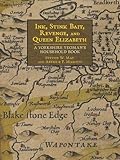Ink, Stink Bait, Revenge, and Queen Elizabeth : A Yorkshire Yeoman's Household Book / Steven W. May, Arthur F. Marotti.
Material type: TextSeries: A Yorkshire yeoman's household bookPublisher: Ithaca, NY : Cornell University Press, [2014]Copyright date: ©2014Description: 1 online resource (288 p.) : 10 halftones, 3 chartsContent type:
TextSeries: A Yorkshire yeoman's household bookPublisher: Ithaca, NY : Cornell University Press, [2014]Copyright date: ©2014Description: 1 online resource (288 p.) : 10 halftones, 3 chartsContent type: - 9780801455568
- English literature -- Early modern, 1500-1700 -- History and criticism
- Hanson, John, -- 1517-1599 -- Notebooks, sketchbooks, etc
- Manuscripts, English -- England -- Yorkshire
- England
- Medieval & Renaissance Studies
- HISTORY / Renaissance
- Sixteenth-century England, Middle-class, Spanish Armada, Eland and Beaumont families, Popular culture, Elite culture
- 820.9/003
- PR421
- online - DeGruyter
| Item type | Current library | Call number | URL | Status | Notes | Barcode | |
|---|---|---|---|---|---|---|---|
 eBook
eBook
|
Biblioteca "Angelicum" Pont. Univ. S.Tommaso d'Aquino Nuvola online | online - DeGruyter (Browse shelf(Opens below)) | Online access | Not for loan (Accesso limitato) | Accesso per gli utenti autorizzati / Access for authorized users | (dgr)9780801455568 |
Frontmatter -- Contents -- Illustrations -- Abbreviations -- Acknowledgments -- Introduction -- 1.The Eland-Beaumont Feud -- 2. Two Lost Ballads of the Armada Thanksgiving Celebration -- 3. Verse and Prose from Other Printed Sources -- 4. Other Texts From Manuscript Sources -- 5. Recipes for Ink and Stink Bait plus Other Utilitarian Items -- Conclusion -- Bibliography -- Index
restricted access online access with authorization star
http://purl.org/coar/access_right/c_16ec
In Ink, Stink Bait, Revenge, and Queen Elizabeth, Steven W. May and Arthur F. Marotti present a recently discovered "household book" from sixteenth-century England. Its main scribe, John Hanson, was a yeoman who worked as a legal agent in rural Yorkshire. His book, a miscellaneous collection of documents that he found useful or interesting, is a rare example of a middle-class provincial anthology that contains, in addition to works from the country’s cultural center, items of local interest seldom or never disseminated nationally. Among the literary highlights of the household book are unique copies of two ballads, whose original print versions have been lost, describing Queen Elizabeth’s procession through London after the victory over the Spanish Armada; two poems attributed to Elizabeth herself; and other verse by courtly writers copied from manuscript and print sources. Of local interest is the earliest-known copy of a 126-stanza ballad about a mid-fourteenth-century West Yorkshire feud between the Eland and Beaumont families. The manuscript’s utilitarian items include a verse calendar and poetic Decalogue, model legal documents, real estate records, recipes for inks and fish baits, and instructions for catching rabbits and birds. Hanson combined both professional and recreational interests in his manuscript, including material related to his legal work with wills and real estate transactions.As May and Marotti argue in their cultural and historical interpretation of the text, Hanson’s household book is especially valuable not only for the unusual texts it preserves but also for the ways in which it demonstrates the intersection of the local and national and of popular and elite cultures in early modern England.
Mode of access: Internet via World Wide Web.
In English.
Description based on online resource; title from PDF title page (publisher's Web site, viewed 26. Apr 2024)


